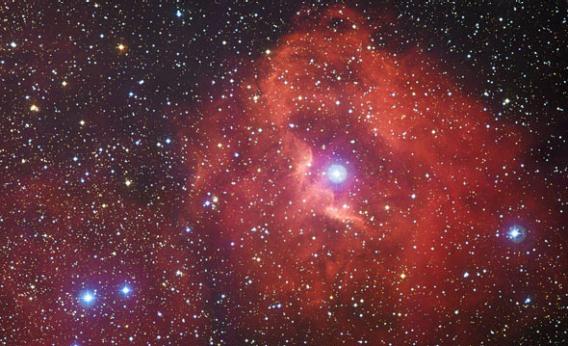Create a free profile to get unlimited access to exclusive videos, sweepstakes, and more!
You Light Up My Gas

Star formation is a seriously gorgeous business. Just look at Gum 41!
That picture above is from the European Southern Observatory’s MPG/ESO 2.2-meter telescope in Chile (wanna see the ginormous 4,000 x 4,000 pixel version? Yes. Yes, you do.). It used filters that more or less mimic what the eye sees, with an added filter that only lets through the light of warm hydrogen gas—that’s the pervasive red glow in the nebula.
Gas like that is a pretty good sign that somewhere nearby, stars are being born … and it’s hard to miss that blue one right in the center of the roughly circular nebula. That star is called HD 100099, and it’s actually two stars in a tight orbit (far too small to be separated on the scale of this picture). Both stars are monster O-types, meaning they are far, far more massive than the Sun, far hotter, and ridiculously brighter. Either one would be enough to light up the gas around it, but both together blast the gas with vast amounts of ultraviolet light. This heats the gas up, exciting the atoms in it, which respond by glowing with that characteristic and quite lovely red hue.
What results is a classic shape called a Strömgren sphere, named after the astronomer who worked out its physics. The overall shape is roughly spherical, because the edge is defined where the light from the central stars weakens enough that it can no longer excite the gas. There is gas outside that region, but it’s not lit up so we can’t see it.
Not only that, but both stars blow out a fierce wind of subatomic particles, like the solar wind but much more powerful. This carves a cavity in the center of the gas, an expanding bubble snowplowing the material outside it. If you look more closely at the center region you see bright ridges where the wind slams into the surrounding gas, compressing it and making it glow even more brightly:
Together, these processes give this cloud a shape something like a flower, but one a dozen light years across and thousands of light years away.
The nebula was discovered by astronomer Colin Gum (hence the name) and is part of a much larger complex of star-forming gas called IC 2944, also called the Running Chicken Nebula, due to an apparently drug-induced interpretation of the shape looking like the jogging fowl. Interestingly, I thought it was part of the foot, but I’ve seen others say it’s the chicken’s wingtip. I suppose Gallus domesticus is in the eye of the beholder.
Anyway, as you can see, the whole region is littered with glowing gas. It takes massive, hot stars to excite gas like that, and those kinds of stars don’t live very long—a few million years at most. Compare that to the 4.6 billion year age of the Sun and you can see why we call them “young.” And that’s how we know to look for red gas when we want to find stellar nurseries! They’re like neon signs (literally) pointing us to the youngest stars in the galaxy. If you’re looking for amazing science, big red nebulae are what you can look for.
And if you’re looking for beauty, it’s the same. But that’s true for so much of astronomy, and one of the many reasons I love it.
Related Posts
Jaw-Dropping Rotating 3-D Nebula (Yeah, you wanna click that)
An Ionized Rose Would Smell as Sweet
Rudolph the Red-Nosed Strömgren Sphere














